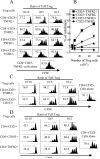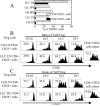Cutting edge: expression of TNFR2 defines a maximally suppressive subset of mouse CD4+CD25+FoxP3+ T regulatory cells: applicability to tumor-infiltrating T regulatory cells
- PMID: 18453563
- PMCID: PMC2699949
- DOI: 10.4049/jimmunol.180.10.6467
Cutting edge: expression of TNFR2 defines a maximally suppressive subset of mouse CD4+CD25+FoxP3+ T regulatory cells: applicability to tumor-infiltrating T regulatory cells
Abstract
TNFR2 is predominantly expressed by a subset of human and mouse CD4(+)CD25(+)FoxP3(+) T regulatory cells (Tregs). In this study, we characterized the phenotype and function of TNFR2(+) Tregs in peripheral lymphoid tissues of normal and tumor-bearing C57BL/6 mice. We found that TNFR2 was expressed on 30-40% of the Tregs of the peripheral activated/memory subset that were most highly suppressive. In contrast, TNFR2(-) Tregs exhibited the phenotype of naive cells and only had minimal suppressive activity. Although not typically considered to be Tregs, CD4(+)CD25(-)TNFR2(+) cells nevertheless possessed moderate suppressive activity. Strikingly, the suppressive activity of TNFR2(+) Tregs was considerably more potent than that of reportedly highly suppressive CD103(+) Tregs. In the Lewis lung carcinoma model, more highly suppressive TNFR2(+) Tregs accumulated intratumorally than in the periphery. Thus, TNFR2 identifies a unique subset of mouse Tregs with an activated/memory phenotype and maximal suppressive activity that may account for tumor-infiltrating lymphocyte-mediated immune evasion by tumors.
Figures



References
-
- Aggarwal BB. Signalling pathways of the TNF superfamily: a double-edged sword. Nat Rev Immunol. 2003;3:745–756. - PubMed
-
- Szlosarek PW, Balkwill FR. Tumour necrosis factor alpha: a potential target for the therapy of solid tumours. Lancet Oncol. 2003;4:565–573. - PubMed
-
- Chen X, Baumel M, Mannel DN, Howard OM, Oppenheim JJ. Interaction of TNF with TNF Receptor Type 2 Promotes Expansion and Function of Mouse CD4+CD25+ T Regulatory Cells. J Immunol. 2007;179:154–161. - PubMed
Publication types
MeSH terms
Substances
Grants and funding
LinkOut - more resources
Full Text Sources
Other Literature Sources
Research Materials

